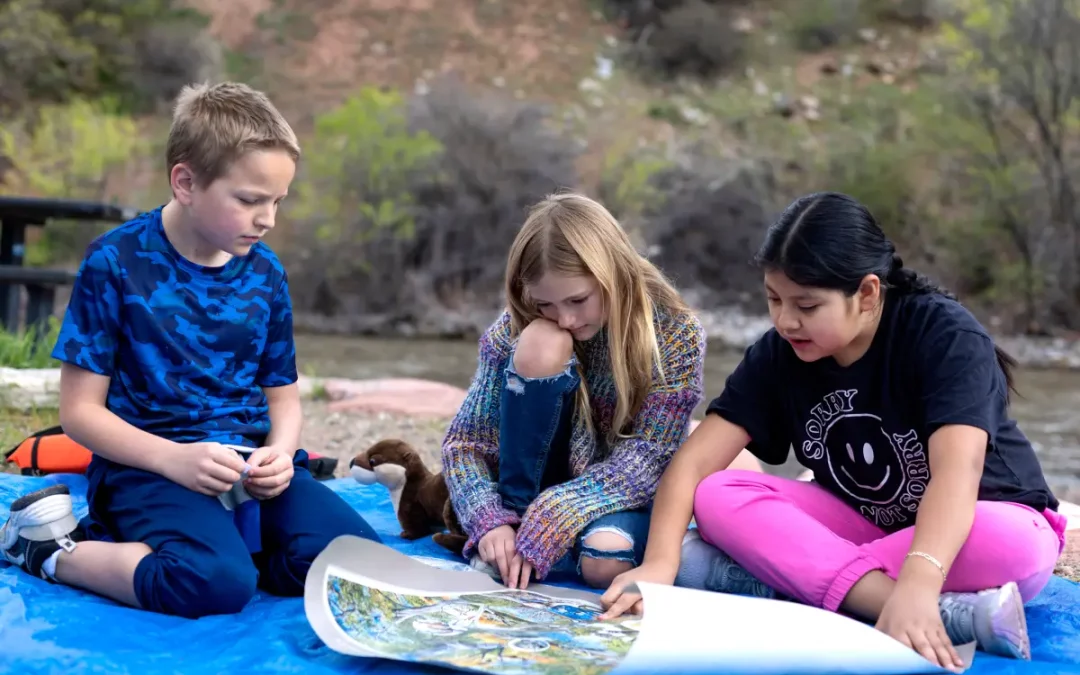GLENWOOD SPRINGS — On an early morning in mid-May, elementary school students in Cherry Creek and Glenwood Springs clicked into a video conference call. After writing letters to each other for months, they were meeting their pen pals for the first time.
“Hieeee,” one student said as others shared a flurry of emoji hearts, laughing faces and thumbs ups on the video call. Then, on opposite sides of the state, teachers walked computers around their classrooms while the students giggled their way through introducing themselves.
It was the final day of a water education program that uses science and old-fashioned letter writing to bridge geographical and cultural divides in Colorado.
Despite going to schools 176 miles apart, the students share one water source: the Roaring Fork River on the west side of the Rocky Mountains in Colorado. As participants in the award-winning Watershed Pen Pal Program, they spent the year learning about water that falls into the Roaring Fork Valley: How it reaches Western Slope communities, like Glenwood Springs, travels 150 miles over 11 days to Front Range cities — and how it should be protected and shared.
Delivering water across the Continental Divide in Colorado has caused fisticuffs in the state’s early years. After learning more about the state’s water systems, the students said it plain and simple: Sharing water is important because everyone needs it to survive.
“I think sharing is important because it gives more trust to the other place so that they can rely on us,” said Alex Luengas, 9, a fourth grade student at Sopris Elementary School.
The Roaring Fork Conservancy, a Western Slope environmental nonprofit based in Basalt, established the Watershed Pen Pal Program in 2022 and brought on Aurora Water, a Front Range utility provider, to help develop it.
The program uses videos, field trips, classroom lessons and letter writing to teach students about everything from grammar to water ethics, river ecology and water chemistry. Since it began, 740 students have participated from two Western Slope schools, Sopris Elementary and Basalt Middle, and two Front Range schools, Vista Peak Exploratory and Dakota Valley in Aurora.

Megan Dean, director of education at Roaring Fork Conservancy, had the idea for the program after realizing that people across the state did not know where their water came from, or about the many different users, like farmers, power plants, cities, ski resorts and wildlife.
“I’m hoping that, if people understand where their water comes from and how precious it is, that they will make conservation a priority in their decision-making,” she said.
Digging into water woes
Talk about saving and sharing water has heated up in recent years. The state’s climate is warming, which impacts rivers and the mountain snowpack, a key water source for Coloradans, 19 states and Mexico.
When water falls west of the Continental Divide in Colorado, it flows into the Colorado River Basin, where the future water supply for 40 million people is at risk because of overuse and prolonged drought.
Tunnels, reservoirs, ditches and streams deliver water from the Western Slope — where most of the state’s water flows — to the Front Range, where most of the state’s population lives. Early water rights were snapped up by settlers for farming, but now growing cities are looking to farms to bolster their water supplies.
“Water is a limited resource in Colorado, especially in the Colorado River Basin and in years of drought,” said Sherry Meschko, an education program specialist with Aurora Water who works with the pen pal program. “It will take all of us, across Colorado and in other states conserving water and implementing solutions to make sure we all have water in the future.”
These dynamics can cause tension. Raft guides have been frustrated that their rivers would be twice the size if water wasn’t diverted to the Front Range, Dean said.
“In the past, I’ve had kids that pick up on, ‘Well I don’t want to share my water.’ And ‘We shouldn’t do that,’” Dean said. “And I love that, by these experiences, we’ve been able to facilitate conversations that go past that.”
In the fall, students on the Western Slope go on a rafting trip to learn about the water cycle, river ecology and water chemistry. One year, nearly 90% of the students had never been rafting before, Dean said, and this summer, students from the Front Range will go on a three-day river trip, a first for the program.
In the spring, Sopris Elementary students hiked down to the Roaring Fork River to learn about riparian ecosystems in a lesson focused on otters and how they share the river with beavers, whose dams can block otters from finding fish.

Sopris Elementary School 4th grade student Gianna Glenn, left, dresses as a river otter as Megan Dean, right, Roaring Rork Conservancy’s director of education, leads a class about riparian life, April 26, 2024, along the Roaring Fork River in Glenwood Springs. (Hugh Carey, The Colorado Sun)

Sopris Elementary School 4th grade students Maddie Army, left, tries to guess what riparian related item provided by Amelia Bresnahan, right, during a class about river otters, April 26, 2024, along the Roaring Fork River in Glenwood Springs. (Hugh Carey, The Colorado Sun)
During lessons, students passed a jug of water down a line of students and found there was not enough for those at the end of the line. They shared water based on birthdays, so the oldest gets the water first, to simulate the state’s water sharing laws. They discussed reasons to use — or not to use — water, and in another lesson, tracked river systems across the entire state. “To see it on a map is really powerful because they could really see our local rivers and how it flows across the Continental Divide,” said Andriana Chance, a 4th grade teacher at Sopris Elementary. “Our students were like, ‘Whoa!’ It was the power of how big it is.”
Crossing divides with the pen
The letter writing portion of the program not only helps students practice grammar and spelling, but it helps build relationships across the Continental Divide, Dean said.
“Facts and figures, even cute slogans and funny commercials or what have you — they’re important, but really when I’ve seen major behavioral changes, those changes come from experiences and relationships,” she said.

Students exchange four letters that answer different questions like, where does my water come from? Or, what Colorado animal, that you like, needs healthy water to survive? They also share their hobbies, interests, and favorite water activities to build relationships with each other and understand their personal connections to water.
“They’re so excited. They’re just elated, asking ‘have the envelopes come yet? Have the letters come?’” Chance said. “They realize that they’re so similar. They have a lot in common with their pen pals.”
Fourth graders Michael Stagg, Gianna Glenn and Maddie Army all realized they and their Front Range pen pals liked to raft and swim, or they all had siblings and liked books or video games. Students learned that, while Glenwood Springs has a population of around 10,000, Aurora has almost 400,000 people.
Colorado should save its water for important things like drinking, watering farms so food can grow, and leaving water for animals to drink, said Jack Schooler, an 11-year-old at Vista Peak Exploratory in Aurora.
“Water is one thing that everyone needs to survive,” Schooler said. “We need to be careful and not use more water than our system has.”



 Print
Print